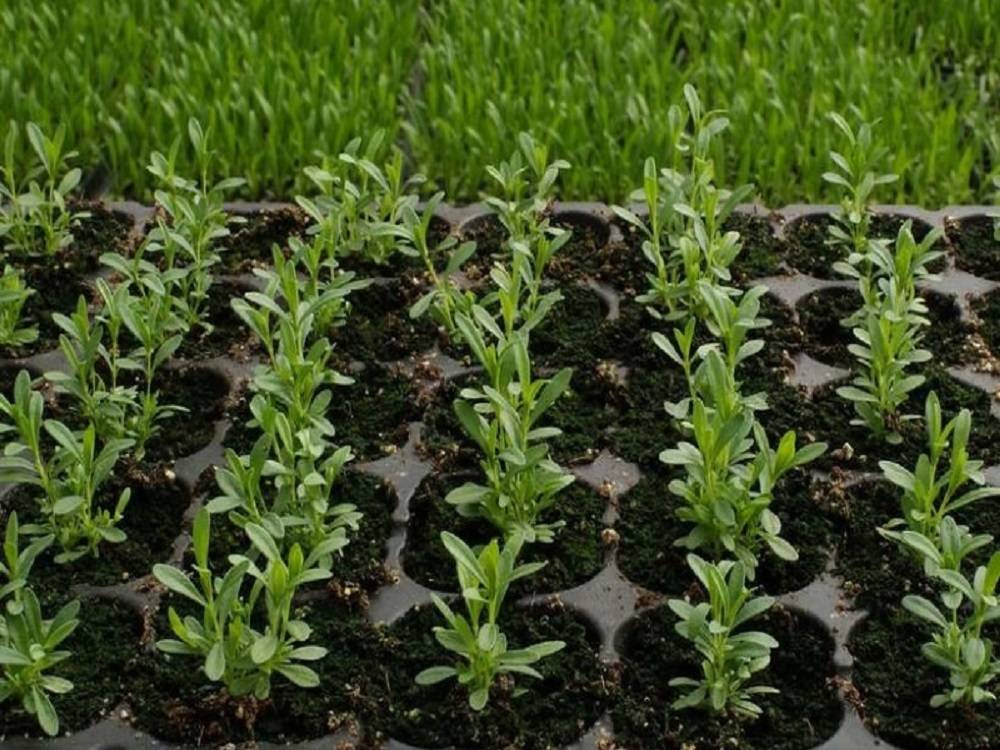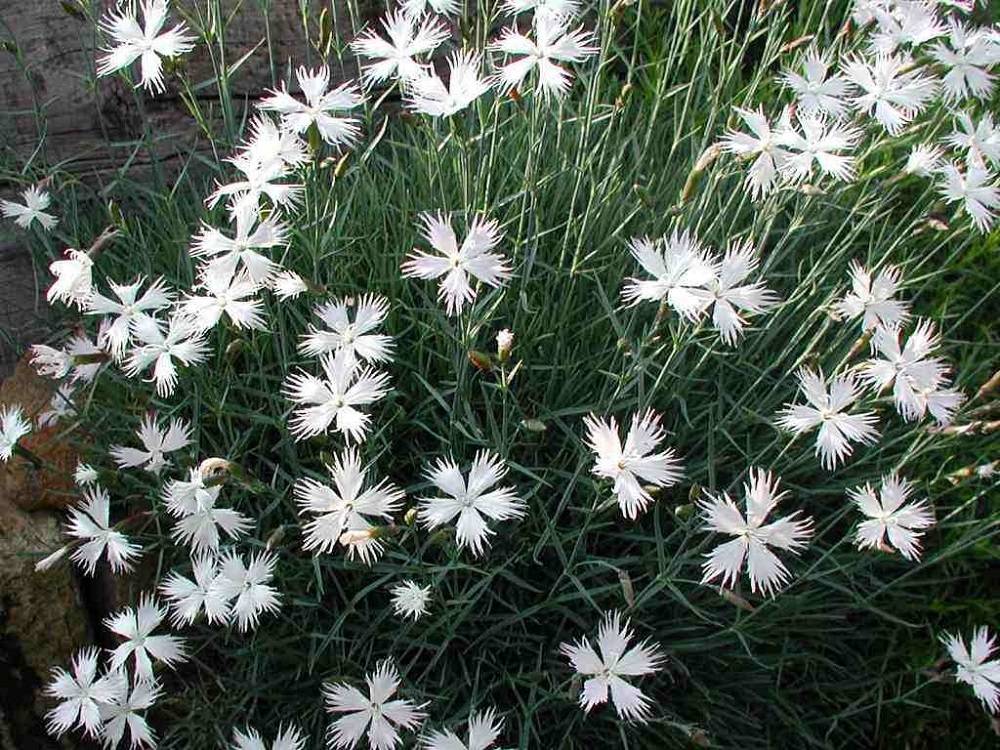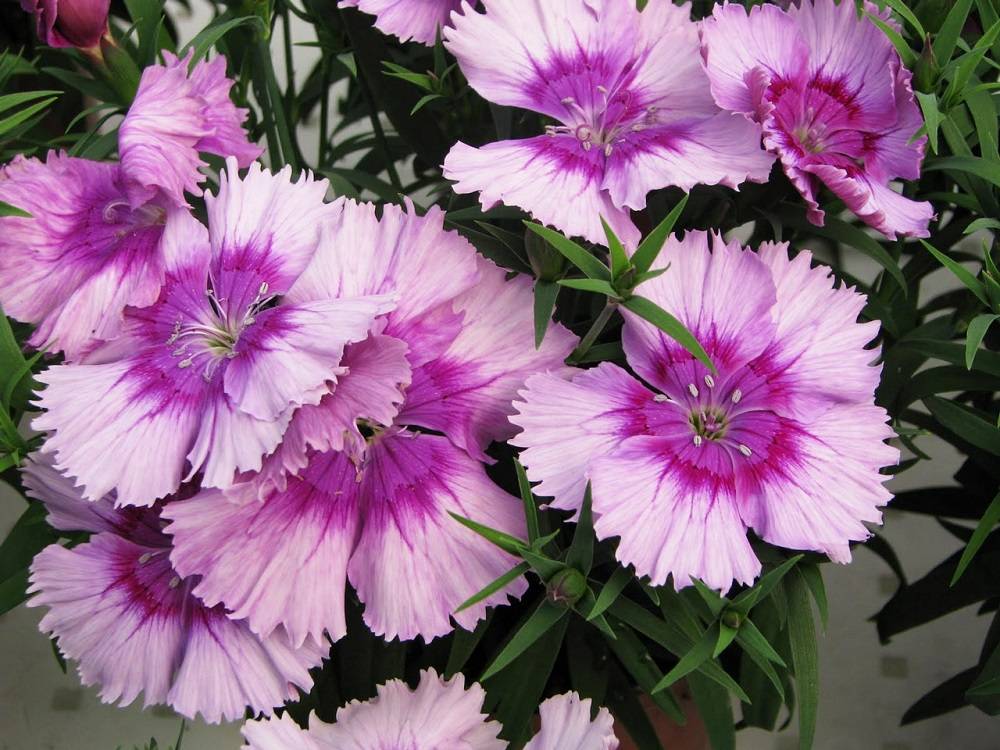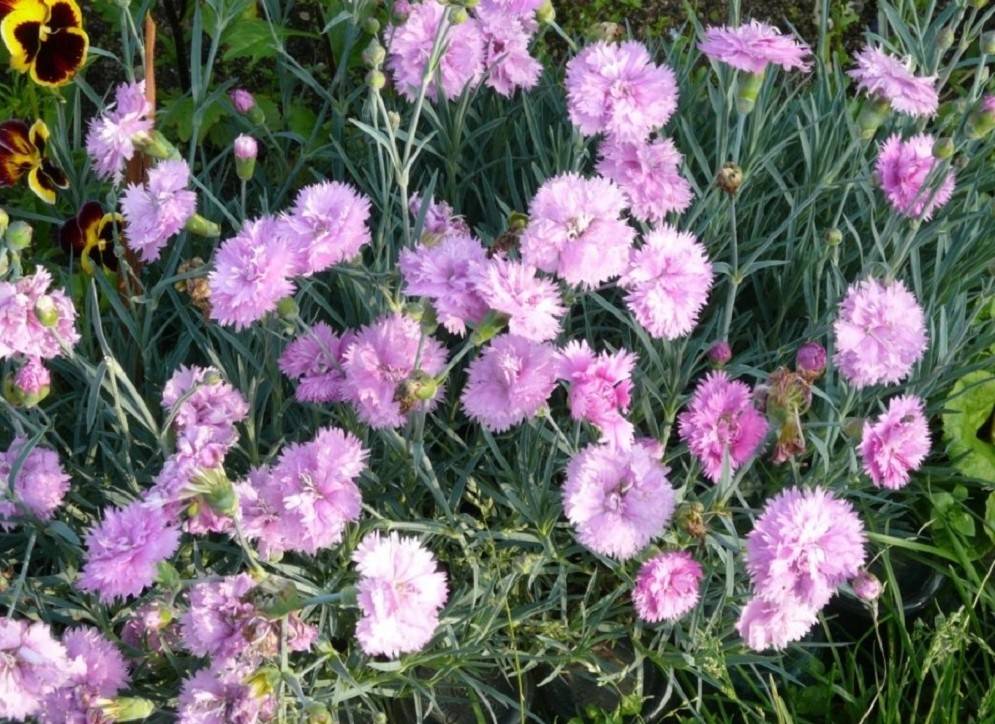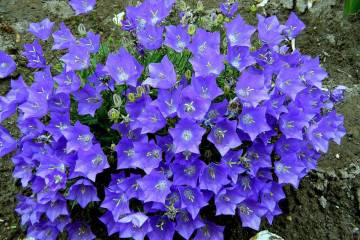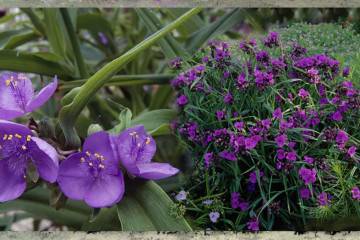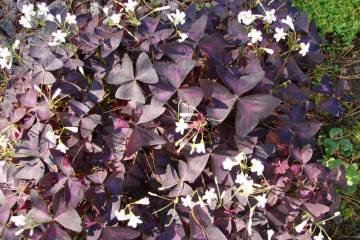Perennial carnation - planting in the garden and care
Content:
- Perennial carnation: growing from seeds
- Annual carnation - plant benefits
- How best to propagate a perennial carnation
- Popular types and varieties of perennial carnation
- Perennial carnation: planting and care in the open field
- Carnation propagation by cuttings
- Carnation care in flower beds
- Clove disease prevention and pest control
Gardeners who want to decorate their beds with a beautiful, fragrant flower that does not require complex maintenance should pay attention to the perennial double carnation. This culture is distinguished by long flowering, so the garden will delight with an abundance of colors throughout the season.
Perennial carnation: growing from seeds
Perennial varieties are best propagated by the seed method. This culture turns out to be stronger and stronger. Seeds are best planted in open ground in spring, when the temperature does not drop below +15 degrees.
Humus is pre-added to the ground, it will help the seeds to germinate faster. After that, the beds should be covered with polyethylene, it is removed only after the shoots appear.
With the appearance of the second leaf, it is necessary to thin out the seedlings, and after the formation of the fifth leaf, pinch the growth point, then lateral processes will form. The first buds will appear one year after planting.
Annual carnation - plant benefits
A flowering crop has a number of advantages over other plants. These include:
- long flowering, which lasts until the onset of severe frost;
- has high drought-resistant indicators, so you can not be afraid that the flower will dry out;
- the buds exude a pleasant spicy smell;
- lush flowering even on the poorest soil;
- not afraid of the scorching sun, as its foliage is covered with wax;
- not afraid of strong wind, strong roots do not break, but bend;
- a large selection of varietal variety.
Each florist will be able to choose a variety for himself that fits perfectly into the landscape of the garden plot. Carnation goes well with both tall and undersized plants, so it can be a decoration for any composition.
Seeds of annuals begin to be sown in late February or early March. The nutrient medium is spread over the bottom of a shallow container. Seeds are distributed from above. For the first 5 days, the containers are kept in a dark place, where the temperature regime is maintained at +20 degrees. Then they are brought out into the light. Before the emergence of shoots, make sure that the soil does not dry out.
This technology allows you to get new hybrid varieties that will delight the owners with their flowering. Cloves for pots are grown in the same way.
How best to propagate a perennial carnation
A blooming culture is famous for its unpretentiousness, so growing it in your garden is as easy as shelling pears. It is also not difficult to obtain new planting material. This can be done using seeds or cuttings. When choosing a particular technology, you need to take into account the variety.
Why is it recommended to grow perennial carnations from seeds
Experienced growers believe that seed propagation of perennial varieties is preferable due to the fact that you can get a flower with a variety of shades of buds. In addition, in this case, it will be possible to grow the plant not only in the open field, but also on your own windowsill.
In addition, cuttings cannot be taken from all bushes, and the variety that you want to grow is not always available. Actually, therefore, it is easier to acquire and grow the seeds of the desired flower.
How to collect seeds for future planting
Most often, the planting material is collected independently. To do this, you need to wait until the plant has faded, and then give time for the seeds to ripen well. After that, they should be carefully collected on paper and dried. Already dry seeds are poured into an airtight package and stored. It is best to keep them in a dark and dry place.
Popular types and varieties of perennial carnation
Perennial garden carnations have many varieties, each type has its own characteristics. There is only one thing that unites them - they were all bred taking into account the cold climate of Russia, so they can be bred without fear in the garden.
Perennial undersized carnation varieties
Flowers very popular and loved by many gardeners. Most often, summer residents prefer varieties such as:
- Sandy;
- Knapp;
- Dutch.
All of them are unpretentious in maintenance, therefore, they are suitable for planting in park areas, city alleys, courtyard flower beds. They do not require any special conditions, they will bloom even on the poorest soil.
What does a Turkish carnation look like?
Cold-resistant, unpretentious crop, suitable for growing in any region of the country. This carnation is two years old, with a strong knobby stem that can grow up to 75 cm. A distinctive feature of the variety is the oblong leaves, painted in a bluish and red tint.
Thyroid inflorescences also differ in palette. The buds can be white, cream, red. The variety called Coal looks especially beautiful. Its black and crimson buds are breathtaking.
Description of Chinese perennial carnation
This is the most unpretentious variety. Most often, the annual is chosen by residents of central Russia. An adult bush can reach a height of 70 cm, and grow up to 25 cm wide. The buds, depending on the species, can be white red pink.
Also, there are often purple eyes in the center of the flower. Up to 15 buds can form on one shrub. The plant blooms until the onset of frost.
Varieties of feathery perennial carnation
Perennial feathery carnation was imported from Europe. This perennial grows up to 30 cm. It differs from other varieties with its silvery-green narrow leaves. The buds are terry, single, reach a diameter of 3 cm. The petals look very unusual, they resemble a fringe.
You can see the beautiful and fragrant flowering from July to the end of August. In the southern regions, the inflorescences are tied much earlier.
Perennial alpine carnation
The shortest representative of the carnation, an adult bush does not grow more than 25 cm. The inflorescences are small, but bright and beautiful. The buds can be colored hot pink, scarlet or crimson.Differs in particular unpretentiousness, grows well even on poor rocky soil. Most often, this variety is used to decorate alpine slides.
Shabo carnation with double flowers
The main distinguishing feature of this species is the peculiarity of its double flowers, they are collected in inflorescences. This variety blooms for a long time, the buds appear in July and delight flower growers until late autumn. The plant grows up to 65-70 cm.
Perennial ground cover carnation
Ground cover crops are popular with landscape designers, and perennial garden carnations are no exception. In addition, this variety is unpretentious in care, is famous for its abundant and long flowering.
The Travyanka variety with its creeping shoots is very popular. The plant can even be planted on rocky soil and it will feel quite normal. The only condition is the presence of the sun.
Perennial carnation: planting and care in the open field
Before planting a perennial in a permanent place, you need to prepare the planting holes. A gap of 20 cm should be left between the bushes. As for the depth, it should correspond to the root coma. The outer layer of the earth should be loose, so the soil should be mixed with sand.
The seedling is placed in the center of the pit, the root system is carefully straightened. After that, sprinkle with a substrate, tamp and watered abundantly. It is also recommended to loosen the ground around the young bush.
When to plant perennial carnations for seedlings
Various methods are used to propagate a flowering culture. The timing of planting seed directly depends on the variety and method of planting.
The ideal time for sowing carnation seeds is considered to be the end of February. You can do this earlier, but you will have to provide the plant with additional lighting, since daylight hours will not be enough. In this case, flowering will come much earlier.
Soil preparation and containers
The soil for cloves should be light, nutritious. It can be purchased ready-made, or you can make it at home. For this you will need:
- garden land - 1 part;
- sand - 3 parts;
- compost - 2 parts;
- peat - 1 part.
It is also worth taking care of the containers in which the seeds will be sown in advance. For this, plastic containers, wooden boxes are suitable. Containers, the substrate must be disinfected. The earth is calcined in the oven, and the containers are treated with a solution of potassium permanganate.
Selection and preparation of seeds
First you need to decide on the variety. It is selected taking into account the climatic characteristics of the region. After that, the planting material undergoes special processing. The seeds are soaked for a while in a weak solution of manganese. This is done for disinfection so that the plant does not hurt.
Sowing seeds
Cloves are planted using a special technology: their seeds are not buried, but laid out on the surface of the substrate and sprinkled with a thin layer of wet sand.
After that, the container must be covered with plastic wrap, this will create a greenhouse effect. As soon as the first shoots appear, you need to move the container with seedlings to the southern windowsill, where there is a lot of light. After 30 days, a pick and pinch of the upper part is carried out.
Carnation propagation by cuttings
Many growers propagate a flowering plant by cuttings. This procedure is not difficult if you know a few tricks. In addition, this technology allows you to achieve faster flowering, the inflorescences will be tied up in the year of planting.
Cuttings are cut in the last days of May. To do this, examine the bush, choose a healthy and strong shoot, on which there are 3-4 leaves. All other foliage is removed. Make an oblique cut with a sharp knife or pruner.
After that, the resulting cutting is buried in a moistened nutrient substrate, it should be light and sandy. After 20 days, the young plant will give roots, and the seedling itself will grow.
How and when to divide the bush
Reproduction by dividing the bush is carried out in early spring. An adult plant is dug up entirely and divided into the required number of parts. After that, the roots are cleaned of the ground and seated in separate holes.
It is worth noting that this option is not suitable for every variety, since in some plants the taproot cannot be divided.
Growing and caring for young carnation plants
Young seedlings need special care, only in this case they will develop fully. The soil should always be moist, so watering should be done frequently. Drying out of the soil should never be allowed.
It is also important to pinch the top of the shoots, then the shoots will develop in breadth, and not stretch up. Loosening of the substrate, removal of weeds is mandatory.
When to plant carnation seedlings in the ground
It is possible to plant seedlings on the site only when the cold weather recedes. The ground must warm up well, otherwise young seedlings may simply freeze. In the middle lane, the end of May is considered the ideal time for planting.
In the southern regions, this can be done a little earlier, and in the northern regions, on the contrary, a little later. It all depends on the climate and weather.
How to choose a place for planting carnations
It is important to think in advance about the place in which the plant will grow. Sunny areas are ideal for this perennial. As for the substrate, it is selected depending on the type. Some require nutritious soil, while others prefer to grow in poor, rocky soil.
Carnation care in flower beds
Despite the fact that a garden carnation is considered an unpretentious flower, it still needs care. Even a novice gardener who has no experience in the cultivation of a flowering culture can carry out these procedures.
Watering activities must be approached responsibly. Carnations do not like waterlogging, so they should not be poured. Also, do not plant them next to moisture-loving representatives. It is necessary to moisten the culture only when the substrate is already dry.
Perennial garden carnation needs support or a garter. This is because the abundant flowering and heavy buds often break the shoots. This happens especially often in dwarf varieties. To avoid this, you need to drive a peg next to the plant and tie the flower to it. But do not tighten too much, otherwise the stems may be damaged.
Clove disease prevention and pest control
Perennial bush carnation is extremely rare. Most often this happens due to improper care. That is why it is so important to familiarize yourself with the rules for growing these fragrant flowers.
Typical diseases of clove
Problems that carnation owners may face are associated with waterlogging of the soil. This happens with excessive watering or during rainy summers. In this case, rot may appear. You can understand that the bush was struck by this disease by the following symptoms:
- weak stem;
- leaves turn yellow;
- shoots turn red.
It is impossible to correct the situation, the plant must be dug up and must be burned. And spill the earth with a fungicidal solution. Spider mites and aphids can also attack the plant. These insects are fought with chemicals - insecticides.
In spring, young shrubs are often attacked by rodents.This problem should be taken care of in advance. It is necessary to set traps in autumn, to spread the pestilence.
How can cloves be treated for disease prevention?
It is best to take care of the blooming culture in advance. Many growers pickle seeds with a solution of potassium permanganate. Also, as a preventive measure, it is recommended to steam the soil that will be used for planting.
They perfectly disinfect the substrate with the Trichodermin solution. It is applied immediately before planting seedlings in open ground.
When growing a carnation, do not forget about timely watering, loosening, and fertilization. All these procedures promote good growth and flowering, and are also an excellent prevention against the appearance of diseases and harmful insects.

